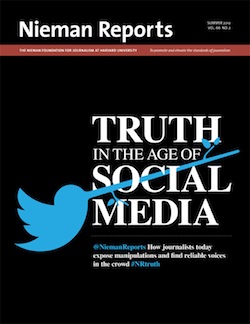Editor’s Note: Our colleagues upstairs at Nieman Reports are out with their Summer 2012 issue, “Truth in the Age of Social Media,” which focuses on issues like verification, crowdsourcing, and citizen journalism. Over the next few days, we’ll give you a glimpse at some of their stories — but make sure to read the issue in full. In this piece, you’ll get a behind-the-scenes look at the BBC’s User-Generated Content (UGC) Hub.
 A group of soldiers speaking Arabic shovel sand into a pit while a disembodied voice wails. After a few seconds it becomes apparent that the desperate voice is coming from a man buried in the trench; the head alone is visible.
A group of soldiers speaking Arabic shovel sand into a pit while a disembodied voice wails. After a few seconds it becomes apparent that the desperate voice is coming from a man buried in the trench; the head alone is visible.
The soldiers — a number dressed, incongruously, in sneakers — appear to reply with gloating taunts. But they are mainly concentrating on the job at hand: covering the victim’s head in earth. They do their grisly job well; in less than a minute his head is completely buried. The video then ends abruptly — the rest is silence.
One rain-swept morning in April, Trushar Barot, assistant editor at the BBC’s User-Generated Content (UGC) Hub in London’s rather bleakly monolithic BBC Television Centre, was studying the anonymously posted footage on YouTube. His Twitter feed was buzzing with news of the clip. Jon Williams, the BBC’s world news editor, had also raised it at the 9 o’clock news meeting. What everyone wanted to know, on Twitter and in the newsroom, was this: Was the video real or fake? That is the kind of question the Hub is there to investigate.
Started in 2005 to sift through unsolicited contributions previously perused by many different teams, the Hub has grown to a complement of 20 staffers. Initially, the team focused heavily on images, footage and eyewitness accounts e-mailed to the BBC, but in the past few years people have become much more prone to distribute material themselves through Twitter, YouTube, and Facebook. As a result, the number of contributions proffered to the BBC has declined to about 3,000 a day, and the Hub’s task has moved toward semi-conventional newsgathering with a Web 2.0 twist. Staffers now use search terms, see what’s trending on Twitter, and look at the images and footage trusted contacts are discussing on their Twitter streams.